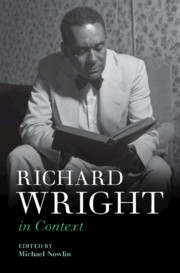Book contents
- Richard Wright in Context
- Richard Wright in Context
- Copyright page
- Contents
- Figures
- Contributors
- Abbreviations
- Richard Wright’s Works: A Chronology
- Introduction Richard Wright’s Luck
- Part I Life and Career, Times and Places
- Chapter 1 Richard Wright’s Triangulated South
- Chapter 2 Richard Wright’s Chicago
- Chapter 3 New York and Brooklyn
- Chapter 4 Paris and Ailly
- Chapter 5 Globetrotting, 1949–1960
- Part II Social and Cultural Contexts
- Part III Literary and Intellectual Contexts
- Part IV Reputation and Critical Reception
- Index
Chapter 2 - Richard Wright’s Chicago
from Part I - Life and Career, Times and Places
Published online by Cambridge University Press: 08 July 2021
- Richard Wright in Context
- Richard Wright in Context
- Copyright page
- Contents
- Figures
- Contributors
- Abbreviations
- Richard Wright’s Works: A Chronology
- Introduction Richard Wright’s Luck
- Part I Life and Career, Times and Places
- Chapter 1 Richard Wright’s Triangulated South
- Chapter 2 Richard Wright’s Chicago
- Chapter 3 New York and Brooklyn
- Chapter 4 Paris and Ailly
- Chapter 5 Globetrotting, 1949–1960
- Part II Social and Cultural Contexts
- Part III Literary and Intellectual Contexts
- Part IV Reputation and Critical Reception
- Index
Summary
In 1927, Richard Wright arrived from Mississippi into Chicago, a city where he stayed for ten years, his most formative years as a writer and a period for him of political and intellectual radicalization. It was in Bronzeville, of course, where Bigger was born. Wright educated himself in Chicago within leftist literary circles, among the artists and writers of the John Reed Club, at the George Cleveland Hall Branch library, and through the interracial collaborations of the WPA’s Illinois Writers Project. Wright wrote stories while working on the project, including “Big Boy Leaves Home” (1938), and he collaborated on a provocative literary manifesto, “Blueprint for Negro Writing” (1937). Wright met sociologist Horace Cayton Jr., for whom he wrote a forceful and luminous introduction to Black Metropolis: A Study of Negro Life in a Northern City (1945), co-authored by Cayton and St. Clair Drake. A kind of ars poetica, Wright’s introduction illuminates how the conditions of Chicago were also the conditions of European fascism, and how the psychological disorder wrought by racism was connected to the burgeoning struggles for decolonization in Africa. Wright also reveals his commitment to both a Chicago tradition of social realism and the experimental styles of transatlantic modernism.
- Type
- Chapter
- Information
- Richard Wright in Context , pp. 22 - 33Publisher: Cambridge University PressPrint publication year: 2021

